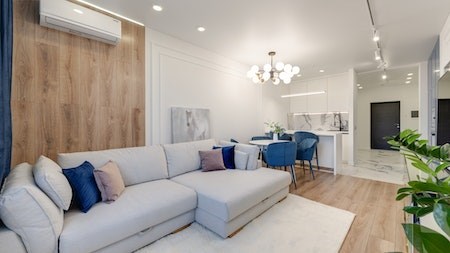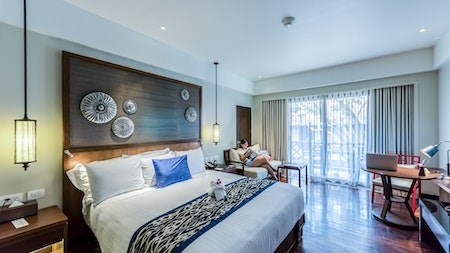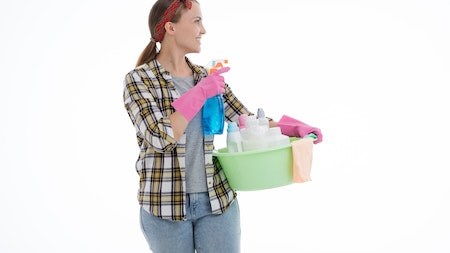With so many wall-covering options available, making the right choice can be tricky. The most recognised categories are wallpaper and paint - and there are plenty of options within just these two.
However, this is just the start and other wall covering materials include wood panelling, ceramic and glass tiles, mirrors, vinyl, and fabric.
Selection criteria
Before you start looking at wall coverings, you need to be aware that your selection will depend on which walls you want to cover.
Rooms with high humidity or moisture like bathrooms and kitchens will need a material that is resistant to water and damp.
High traffic areas such as hallways, passages, and staircases will need coverings that are durable and easy to clean.
Other factors to take into account include:
Existing colours and textures in the room - if you don’t plan to change them.
How light behaves in the room.
Do you want the room to feel bigger or smaller?
Your budget.
Do you want the same wall covering material for all walls? This will impact the cost.
Wallpaper
There are many different types of wallpaper to choose from - from hardwearing printed paper and vinyl to delicate products like flock wallpaper. Most modern wallpapers come in textured or embossed styles, and many are washable.
Printed wallpaper has a printed design that may be slightly textured or embossed. Cheaper variations may be difficult to hang as they are inclined to tear and stretch.
Washable wallpaper is similar to printed paper but has a thin clear plastic topcoat which makes it water and stain-resistant. It can withstand sponging, washing, and gentle rubbing but not scrubbing or use of abrasives. Washable wallpapers are ideal for steamy and humid conditions such as bathrooms or kitchens.
With vinyl wallpapers, the designs are printed onto plastic film, rather than being printed on paper and then coated. Vinyl foil wallpapers have a metallic effect.
Vinyl wallpapers are much tougher and more hard-wearing than washable wallpapers. Stains and marks can be cleaned off, but only if the paper was properly hung. Take care not to lift the seams through over-wetting.
Because they are less likely to become damaged and are easily cleaned, vinyl wallpapers are ideal for hallways, passages, staircases, landings, children’s rooms, and any areas that are prone to contact, brushing, and scraping. They are generally more expensive than printed paper and washable wallpaper but are also of a higher quality.
- Flock wallpaper can be printed paper or vinyl with a raised velvet-pile effect. This is created with fine wool or silk fibres on paper and synthetic fibres on vinyl. You need to take great care when hanging the paper ones as they are prone to tear and wrinkle. But the vinyl types are tough and hardwearing as well as easier to hang.
Tiles
Wall tiles are generally used for walls and splashbacks in kitchens and bathrooms, but there is no reason they can’t be used on other walls in the home.
With a range of colours, materials, shapes, and sizes you can create remarkable tiled artworks - from simple minimalist designs to more complex patterns.
In addition to traditional ceramic, glass, and terracotta tiles, manufacturers are making tiles from lightweight materials to simulate marble, concrete, and reclaimed wood. Tiles made of these materials are far easier to install.
Also popular are metallic-toned tiles that are made to look like brass, copper, gold, and other metals.
Fabric
Fabric wall-coverings can be stylish and cost-effective - and much less time-consuming to install than wallpaper or tiles, for example.
An upholstered headboard makes a strong statement in the bedroom.
Adding a fabric-covered wall in the living room makes the space appear cosier and will also absorb sound.
Padded fabric wall panels are chic and modern. They can be almost any shape or size, and in as many different fabrics and colours you want - rather like a patchwork quilt. Choose simple squares or rectangles, or experiment with different sizes and colours.
Mirrors
Mirrored walls are excellent for creating the illusion that a room is bigger than it really is.
Mirrors open up the space in a room, bouncing off light to make it seem bright and airy. However, mirrored walls are probably not ideal if you have young children or elderly folk around.
Other effects
Covering only part of a wall, or adding some simple decorative features will give your wall definition without being overpowering. Wainscoting and dado rails are useful devices for breaking up an otherwise bland wall.
Wainscoting is usually a complete piece of panelling - traditionally made of wood – reaching up about 1m from the floor. Wainscoting may also cover an entire wall and can be applied to ceilings.
Decorative dado rails also act as a protective barrier in high-traffic areas or spaces where furniture is often moved around. This trim is commonly used in dining rooms, kitchens, living rooms, and entrance halls.
All of these wall-covering materials and techniques can be used by themselves or in conjunction with one another. With this knowledge – and your inspiration – selecting the ideal wall-coverings for your home should be something to look forward to.




